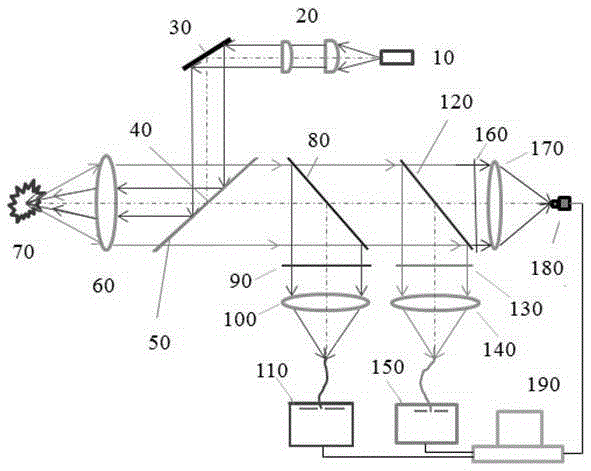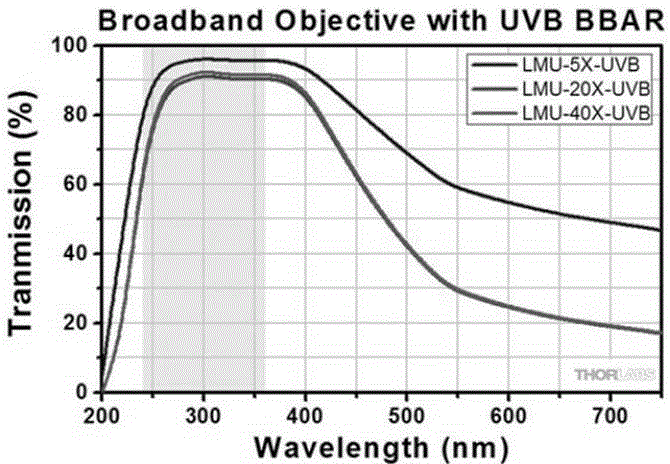Portable three-channel near-deep-UV Raman spectrometer
An ultraviolet Raman and near-deep ultraviolet technology, applied in the field of Raman spectroscopy, can solve the problems of short detection distance, inseparable spectra, interference, etc., and achieve the effect of long detection distance, high resolution and large illumination point
- Summary
- Abstract
- Description
- Claims
- Application Information
AI Technical Summary
Problems solved by technology
Method used
Image
Examples
Embodiment 1
[0062] Such as figure 1 As shown, the laser emits wavelengths of 231nm, 266nm or other near-deep ultraviolet light 10, the light spot is elliptical, and the divergence angle is asymmetrical in the long and short axis directions, so two cylindrical mirrors 20 with different focal lengths are used to shape the laser into a circle For example, the diameter is 1 millimeter or a few millimeters (if only one cylindrical mirror is used for shaping, the light beam will first converge and then diverge, so the second cylindrical mirror should be used to collimate it back), it is reflected by the reflector 30 to the noise Suppression Beamsplitters (also called Dichroic Mirrors or Beamsplitters BS 1 ) 50 with a diameter of 1 millimeter or a few millimeters central part 40, this area is coated with anti-laser high reflective film, it reflects the diameter of 1 millimeter or several millimeters of laser light to a certain diameter (for example 10mm) low power ( For example, 5x) microscope ...
Embodiment 2
[0077] Such as figure 2 As shown, in this design, the long-pass beam splitter BS 1 50 is not only coated with laser high reflective film in the middle but the whole BS 1 It is coated with a film that is almost completely reflective and fully transparent to Raman light, fluorescence and visible light that is greater than laser light. The transmitted BS reflected by the target 1 The Raman light, fluorescence and visible light hit the second long-pass beam splitter BS 2 After 80, it reflects the Raman light to the long-pass Raman filter 90, and is imaged by the relay lens 100 to the head of the Raman fiber bundle and coupled to the slit of the Raman spectrometer 110; And visible light hits the third long-pass beam splitter BS 3 At 120, the shorter fluorescence is reflected to the band-pass filter 130, imaged by the relay lens 140 to the head of the fluorescence fiber bundle and coupled to the slit of the fluorescence spectrometer 150. Through the long pass beam splitter BS ...
Embodiment 3
[0081] Although the above-mentioned design can produce spectra quickly, it takes a long time to scan the entire target due to the small detection point, and the sensitivity of the CCD in the spectrometer to ultraviolet light is not high enough. To overcome these shortcomings, such as Figure 4 As shown, we do not use the grating as the dispersion element and CCD, but use tunable optical filter and high-sensitivity photomultiplier tube PMT or avalanche photodiode APD. Its advantages are high sensitivity, no slit, and no limit to the size of the detection point; its disadvantage is that the spectrum needs to be scanned one wavelength at a time, so the speed of spectrum acquisition is slow, but it can image the entire target to obtain Hyperspectral if the laser is stronger and an imaging charge-coupled device ICCD is used.
[0082] Figure 4 It is a functional block diagram of a near-deep ultraviolet Raman spectrometer using a tunable filter and a PMT or APD detector according ...
PUM
| Property | Measurement | Unit |
|---|---|---|
| Wavelength | aaaaa | aaaaa |
Abstract
Description
Claims
Application Information
 Login to View More
Login to View More - R&D
- Intellectual Property
- Life Sciences
- Materials
- Tech Scout
- Unparalleled Data Quality
- Higher Quality Content
- 60% Fewer Hallucinations
Browse by: Latest US Patents, China's latest patents, Technical Efficacy Thesaurus, Application Domain, Technology Topic, Popular Technical Reports.
© 2025 PatSnap. All rights reserved.Legal|Privacy policy|Modern Slavery Act Transparency Statement|Sitemap|About US| Contact US: help@patsnap.com



